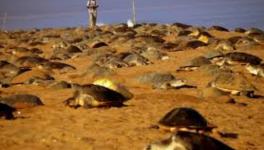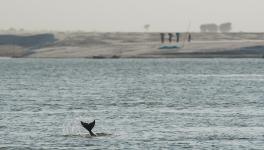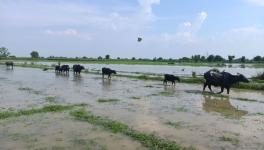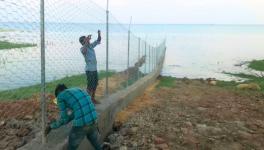Critically Endangered Gharial Count Increases in UP’s Katarniaghat Wildlife Sanctuary
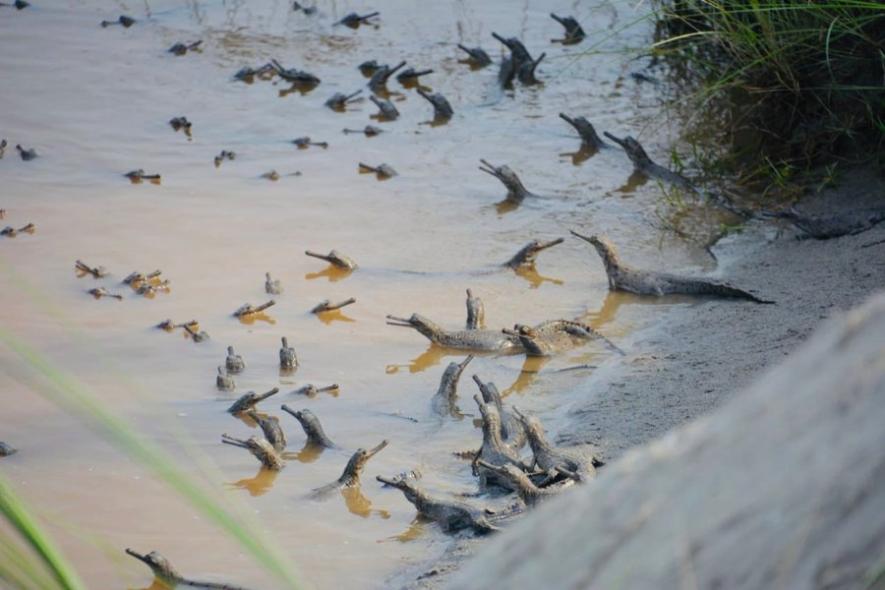
Pic credits: Ashish Pandey
Katarniaghat: In what comes as a rare surprise for conservationists and environmentalists the population of Gharials, an endangered species, has gone up by 50% in the Katarniaghat Wildlife sanctuary.
The counts of Gharial, scientifically known as Gavialis gangeticus, were going down in India till four decades ago and were on the verge of extinction. This species of crocodile, endemic to India, was declared as ‘critically endangered’ by the International Union for Conservation of Nature (IUCN). Following this, the government started the conservation process of this species.
Katarniaghat Wildlife Sanctuary is located in the Terai region in Bahraich district of Uttar Pradesh, near the Nepal border. It is part of the Dudhwa Tiger Reserve. Most of it is wetlands and swamps with the Girwa river winding its way through it, apart from Sal forests and grasslands. This rich, diverse environment provides home to many endangered species including gharial, tiger, rhino, Gangetic dolphin, swamp deer, hispid hare, Bengal florican, the white-backed and long-billed vultures.
Also read: Over 50,000 Trees to be Axed in UP's Tiger Habitat
Ashish Pandey, the field director of Dudhwa National Park says that 32 hatching nests had been spotted on the sand bars on the river Girwa in Katarniaghat Wildlife Sanctuary.
“As many as 852 hatchlings came out of the eggshells from these 32 nests and the forest workers were able to save more than 150 hatchlings,” he said. The present count of the gharials in Katarniaghat is 70 out of which 32 are females, 10 to 12 are males and the rest are sub-adults.
Talking about the difficulties associated with saving this species, Pandey told NewsClick that gharials live in fresh water, but the rising pollution levels in the Ganga had led to the declaration of this species as endangered. “The other reasons behind the rapid decline in their numbers are the threat of predators. For instance, in several cases, the hatchlings are eaten up by crocodiles, dogs and even some birds. Second is the disturbance in their habitat like female gharials not finding sand bars for laying their eggs and the third is that a lot of gharials die when they get caught in fishing nets being used by the fisherfolks. Finally, there is a decline in the population of fish, which is the main food of these gharials, in the fresh waters due to pollution. As a result they are not able to survive,” he said.
Also read: Ganga in Deeper Troubled Waters Than Ever, So Much for Modi’s ‘Namami Gange’
Expressing his happiness on the increase in counts of hatchlings, the field director said, “It could be the world’s best count of hatchlings of a species which is considered as endangered and that too in an area stretching over just one kilometre.”
“It is very important to preserve Gharials. This breed is only found in India and nowhere else in the world. The gharials are found in the upper reaches of Ganga and lower reaches of the Ghaghra river. The Chambal river flowing in the parts of Rajasthan and Madhya Pradesh is the best river for breeding the Gharials as there are no industries on the banks of that river. Efforts of saving this endangered species is showing results as the reptiles have recently been spotted in the Kosi and Gandak rivers too,” he added.
The World Wildlife Fund India has been involved in the Species Recovery Programme ever since the National Chambal Gharial crisis in December 2007. In collaboration with the Uttar Pradesh Forest Department, WWF-India started a gharial reintroduction programme at Hastinapur Wildlife Sanctuary. Since January 2009, 250 captivity-reared gharials from Kukrail Rehabilitation Centre (Lucknow) have been released into River Ganga.
The WWF also lists illegal sand mining as one of the main reasons behind the danger of extinction to this species.
On being asked about the efforts being taken by the Dudhwa Tiger Reserve staff to conserve the hatchlings, the field director said, “The pattern of hatchlings was observed and then the sand bars were protected using tall grass from predators which helped in increasing the numbers of hatchlings.”
He further told NewsClick that all the 150 hatchlings have been kept under a strict vigil and will be released in the river during winters as the survival rate becomes higher during that season.
The Gharial was listed in the schedule I of the Wildlife Protection Act 1972 and is Critically Endangered on IUCN Red list. There are about 800 gharials in India as of now in Ganga river and its tributaries.
Also read: Gangetic Dolphin Population Stable in Bihar
According to S K Pandey, an officer posted at the Kukrain Gharial Conservation Centre in Lucknow, the increase in hatchlings is a good sign for the ecological balance. "The breeding of gharial is not at all easy but it is good to know that it has increased naturally when a lot of emphasis is being paid on the artificial techniques," he said.
Get the latest reports & analysis with people's perspective on Protests, movements & deep analytical videos, discussions of the current affairs in your Telegram app. Subscribe to NewsClick's Telegram channel & get Real-Time updates on stories, as they get published on our website.









